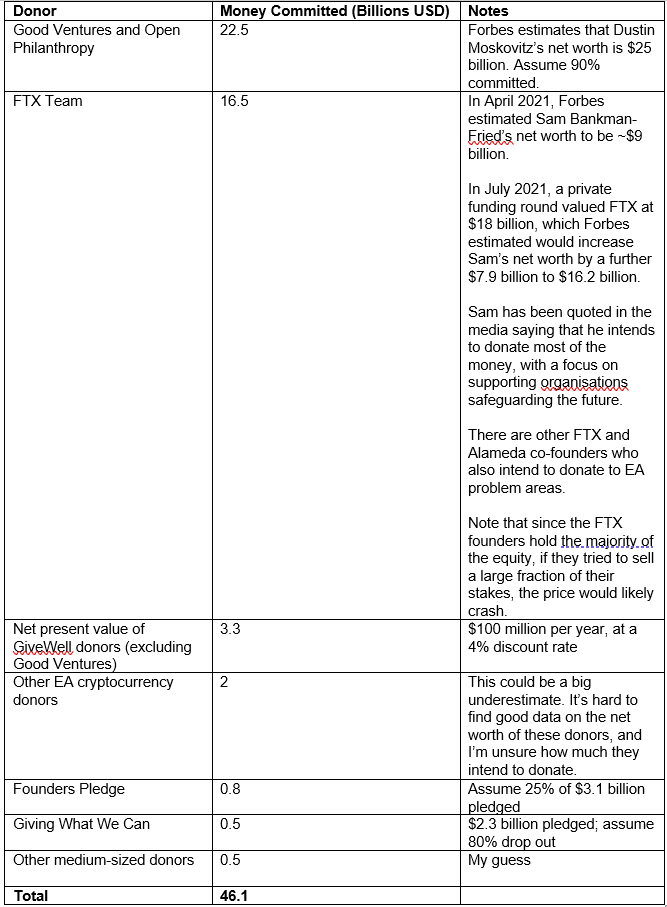Roman Ugarte: Dissecting EA’s Balance Sheet
The effective altruism (EA) movement certainly feels like it’s growing rapidly: donors are making news headlines, university groups are expanding, and the community feels more vibrant than ever.
However, how has the wider adoption of EA as a worldview translated to the bottom-line of “doing good better,” the movement’s core mission—and how far is still left to go? Using rough estimates for EA’s donor base and deployment schedule, I’ll attempt a “status update” on EA’s philanthropic—not just cultural—impact.
Inflows
You can picture the effective altruism equation as having two sides: supply and demand. The supply is the pool of funds from EA-minded donors, typically coming from either (a) high net worth EA believers (e.g., billionaire Sam Bankman-Fried) or (b) a syndicate of smaller donations organized around an EA-related goal (e.g., Founders Pledge).
This is, understandably, quite difficult to estimate, but Benjamin Todd gave it his best guess in July 2021, arriving at $46.1B in committed funds. He lays out his methodology in the table below:
While this estimate feels like it’s in the ballpark, I updated some of the specific values from last year, keeping the weights and methodology the same. With those updates—most notably, a sizeable decrease in Moskovitz’s net worth and growth in FTX-related philanthropy—the total commitments drop down to $43B.
This $43B serves as the “EA endowment,” or the funds committed for future deployment. One important takeaway, which is immediately obvious from looking at the data, is the impact of ultra-rich individuals on effective philanthropy. Moskovitz and Sam Bankman-Fried, both deca-billionaires, account for over 80% of EA’s committed capital, while “retail” donors account for only a tiny sliver.
This reveals the disproportionate impact that a tiny share of the overall EA community has on overall contributions. As a non-billionaire, is the best way to support the cause to donate your time instead of your money? If you don’t plan on amassing an asymmetrically high amount of wealth, this certainly seems to be the case—and, anecdotally, many community members seem to be giving with their time instead of their paychecks.
Outflows
From Todd’s experience, there are two main deployers of EA funds: Open Philanthropy and GiveWell. In aggregate, they put around $420M toward effective causes. This year, however, a new mega-deployer has emerged: the FTX Future Fund. It promises to deploy at least $100M—and potentially up to $1B—per year.
With this in mind, I’d estimate that $600M will be injected into EA-minded organizations per year for the next few years. This would mean approximately 1.4% of the $43B “EA endowment” is being donated per year. According to Todd, “at the 2020 EA Leaders Forum, the median estimate was that we should aim to donate 3% of capital per year,” so this puts the community below target.
As individuals, this perhaps means that we should de-prioritize “saving to give later” and instead shift to giving now; we seem to be behind schedule in deploying committed funds. However, some prediction markets indicate a higher deployment rate of Open Philanthropy in the next decade, which would go a long way toward closing this gap.
Conclusion
Of course, these back-of-the-napkin calculations overlook a few key points:
There’s a high degree of error in both the inflows (±$15B) and outflows (±$200M) estimates.
Money isn’t everything. As mentioned above, many EA community members give their time—their “80,000 hours,” so to speak.
Just because someone doesn’t earmark their funds as “going to EA” doesn’t mean that they’re not giving effectively.
With that being said, this exercise reveals a few things about where EA currently stands:
In the grand scheme of total philanthropy (~$500B per year from the US), EA’s deployment of ~$600M is a drop in the bucket (around 1%). There’s still a long way for the movement to go!
We’re under-performing the target of donating 3% of committed capital per year. This could imply that donors should skew towards donating now versus later.
The vast majority of EA contributions are from ultra-wealthy donors—two individuals (Moskovitz and Bankman-Fried) make up nearly 80% of expected donations.


